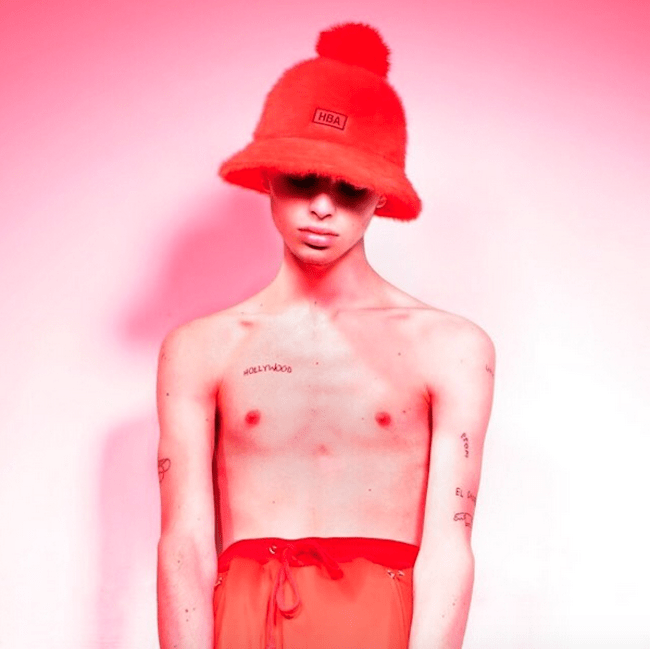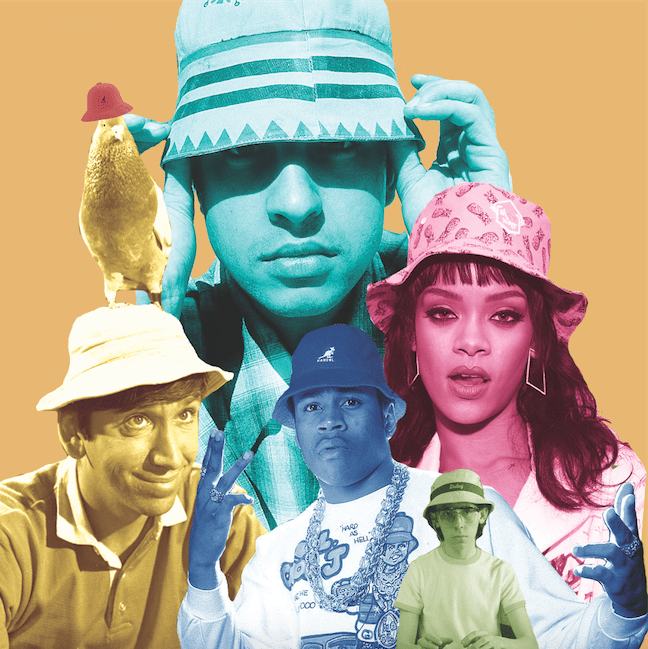One Friday last summer, a friend invited me to walk from Brooklyn to the Bronx in 90 percent humidity. He materialized at the Williamsburg Bridge looking like Hunter S. Thompson, in a hat reminiscent of an upturned flowerpot made of white cotton. He looked like a giant baby, but his bucket hat also held the implicit promise that even the most mundane expedition could transform into a gonzo experience.
Love them or hate them, bucket hats are a newly revived sensation on the streets of New York and on fashion runways. Last spring, Rihanna‘s best friend, Melissa Forde, introduced a line of bucket hats in ikat and pineapple prints at Opening Ceremony, and Tommy Hilfiger sent crocheted versions in Rasta-inspired rainbow stripes down his catwalk in September. Then, this February, Shayne Oliver, the founder of the definitive New York brand Hood By Air, collaborated with Kangol to reinvent its LL Cool J-beloved Bermuda Casual style, with an HBA logo stamp and a detachable bobble on the crown.

How a practical accessory originally known as an “Irish walking hat” — designed to deflect the beating rains of County Donegal — developed into a must-have lid for trendsetters is an unlikely story. But the bucket hat’s purposefully inelegant functionality has made it a blank canvas for over a century’s worth of diverse cultural connotations. Perhaps no other accessory has fans as iconic but disparate as: Gilligan, Carl Spackler from Caddyshack, Ja Rule, Lauryn Hill, RunDMC, Liam Gallagher, Alan “Reni” Wren of the Stone Roses, Dudley from The Royal Tenenbaums, and Nicole Kidman when she’s shielding her porcelain, sunblock-slathered skin on a beach vacation. The bucket hat has an unpretentious utility that transmits one of two messages: “I don’t care,” or “I’m cool enough to get away with this.”
The Irish created the original bucket hat in the early 20th century to counter the harsh weather endured by their country’s farmers and fisherman. Fashioned from lanolin-rich raw tweed and concluding in a narrow downward-sloping brim, the hat was water-resistant and, as outdoor sportsmen soon discovered, flexible enough to be stuffed into a Barbour pocket. The Israel Defense Forces presented a similar round-topped and soft version, as did the US military, during the Vietnam War. But the style immortalized by both Gilligan’s Island and Hunter S. Thompson is the true prototype for today’s bucket hat, cut from cotton canvas and studded with two opposing metal eyelets for ventilation.
As far as we know, the hat first appeared in hip-hop on the head of Big Bank Hank during a 1979 Sugarhill Gang performance of “Rapper’s Delight” on the seminal disco television show Soap Factory. However, the bucket hat’s most famous rap-world representative, LL Cool J, wouldn’t don his signature Kangol Bermuda Casual until the promotional images for his 1985 album Radio. By 1989, when LL was cruising through LA in the video for “Going Back to Cali” in a canvas version of his signature accessory, the bucket hat was already a hiphop fixture, worn by the likes of Run-DMC and Jaz-O. Half a decade later, though, the bucket hat became symbolic of a very different music genre. Reincarnated as “the session hat,” it defined the look of Liam Gallagher, the drummer Reni from the Stone Roses, and the festival-going Oasis fans of the mid 90s. And solidifying its place in popular culture, a bucket hat prominently appears in the video for Rihanna’s “Work.”
The bucket hat’s reassuringly functional appeal has never died. From normcore New Yorkers to Celtic fishermen, from rappers to the cast of Dawson’s Creek in an iconic 1998 J. Crew catalog, its diverse fan base defines its legacy. Like any piece of good design, it is, above all, democratic.
This article appears in the April issue of VICE Magazine.
READ: A History of Tie-Dye, from Woodstock to ‘Wayne’s World’
VOTE for i-D at this year’s Webby Awards for Best Fashion And Beauty Website
Credits
Text Alice Newell-Hanson
Image Elizabeth Renstrom
